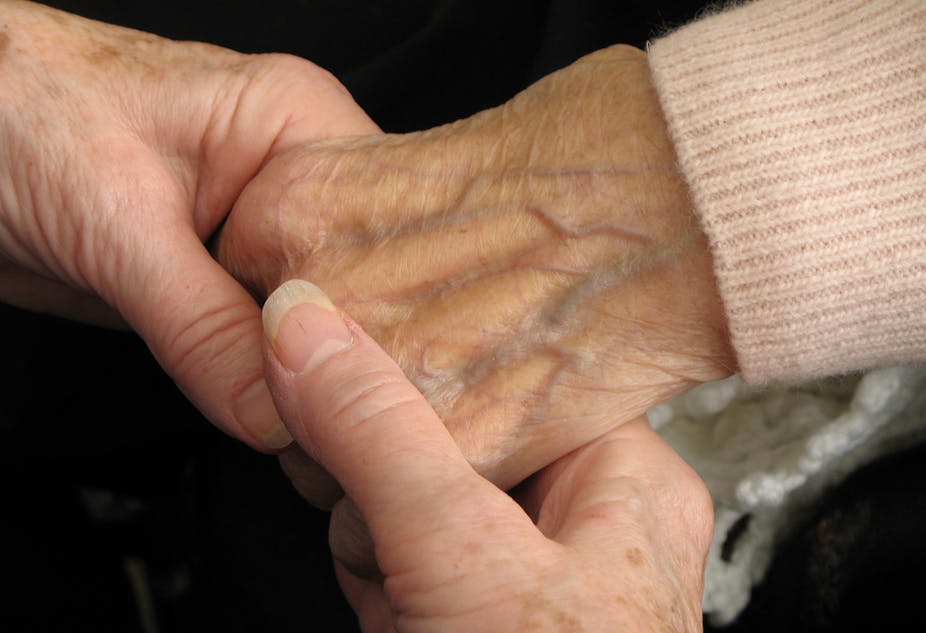Dementia has been described as a ticking time bomb, with the number of those affected predicted to double in the next two decades. But a new study suggests that the prevalence of people with dementia in the UK has actually fallen over the past 20 years.
With no cure yet on the horizon, why does the prevalence of the disease appear to be falling? And is it counterproductive for advocacy groups to raise fears by describing it as a dementia “crisis”?
What the figures say
The findings, based on data from participants aged over 65 and living in Cambridgeshire, Newcastle and Nottingham, appears to be in line with a much larger Europe-wide study published by Alzheimer Co-operative Valuation in Europe (Alcove).
The researchers in England looked at 7,000 people randomly chosen between 1989 and 1994 and asked them about their lifestyle, health and socio-economic status. Nearly 8,000 more were recruited again between 2008 and 2011. Around 1,500 were tested for dementia.
Based on the estimated prevalence of dementia 20 years ago, the researchers then estimated that some 880,000 within the UK would be expected to have dementia by now (about 8% of people aged over 65). But this local study suggests a national prevalence of around 670,000 people (6.5% of the over 65 population). Overall, this is a fall of nearly a quarter in the number of people expected to have dementia.
Dementia prevalence still remains higher in women. In care homes it has increased, from over a half of residents 20 years ago. A recent Scottish study in 2011 found 90%.
Keeping up the funding
There are two possible reasons for the overall fall in prevalence: studies may be getting more rigorous and more accurate, or we’ve significantly improved our health over the last 20 years which has led to less of us getting dementia. More work would be needed to tease this out.
Richard Horton, Editor-in-Chief of the Lancet, said he hoped that the findings didn’t lead to a reduction in much-needed funding for dementia care and research. “Dementia remains a substantial challenge for those affected, their families, the NHS, and the Treasury,” he said.
Researchers always worry about this, and it’s particularly awkward to ask for money for a problem that could be even remotely perceived as going away.
However, perhaps more importantly than the numbers is how we effectively diagnose and treat people with the condition.
A dementia map of the UK
Last year David Cameron launched the dementia challenge and a doubling of funding for dementia research to £66m by 2015.
But even so funding for dementia research in the UK is still only a fraction of what is spent on cancer research. This is ironic when dementia costs society some £23bn a year - more than cancer, heart disease and stroke put together.
But as Horton also said: “We need to understand better why the prevalence of dementia has fallen and what that means for prevention and treatment services.”
The researchers suggest that policy makers are working with inaccurate or misleading statistics. This implies that policies are more based on evidence than on sentiment created by lobbying and political opportunism. I don’t believe this is the case and here’s the laboratory to test it.
The statistics about dementia are arguably the same all across the UK, and we can compare how four sets of policy makers have responded in England, Scotland, Wales and Northern Ireland. Each of the four health departments has a different policy. But let’s look at one outcome: can you get a diagnosis and therefore access to medication and other available support?
Based on the same statistics on prevalence of dementia, each country made a different policy at a different time and got hugely different outcomes. In Northern Ireland, for example, you have a 63% chance of being diagnosed by the health system, but in England it’s 42%.
This postcode lottery is a scandal but averaging out the figure for England, Wales and Northern Ireland easily buries such differences.
Hope over hype
The reduction in dementia prevalence is reason to celebrate. Much of the response to dementia is expensive and stupid - for example admitting people with dementia into hospital when it’s not the best place for them to be - so the idea of a reduction in the number of potential victims of the health and social care system is brilliant.
But how dementia is framed in the media and by advocacy groups is significant. Internationally it is represented as an enemy that has to be fought. It’s a “crisis”, a “rising tide” or “an epidemic” - or indeed the ticking time bomb. But in whose interest is it to represent it as a catastrophe?
There is a perverse incentive for fundraisers and lobbyists to have it presented in a negative light. The danger of that sort of language is that it makes people very worried without actually improving care or accelerating change. We’ve had Baroness Mary Warnock advocating for suicide for people with dementia and author Terry Pratchet has spoken out in favour of euthanasia. Better dead than demented, apparently. But there is still so much more that can be done to improve care and combat the condition.
Lifestyle changes, such as stopping smoking, nutrition and better management of conditions such as diabetes, can delay the onset of dementia symptoms, or reduce the likelihood of contracting underlying diseases that cause symptoms including Alzheimer’s and vascular disease.
Cambridge’s Professor Carol Brayne, who led the Lancet study, says that the gains made from the fall in prevalence and, whether this continues into the future, “depend on whether further improvements in primary prevention and effective healthcare for conditions which increase dementia risk can be achieved.”
She’s right. It’s not just the numbers but what we do with them that matters.

